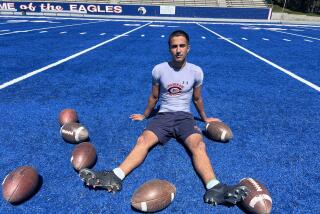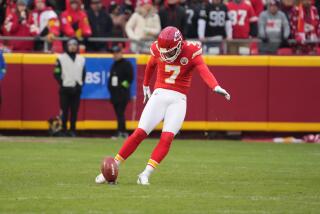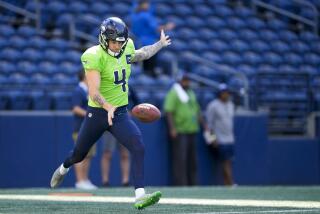Ask Farmer: How did the term ‘punter’ originate?

- Share via
Have a question about the NFL? Ask Times NFL writer Sam Farmer, and he will answer as many as he can online and in the Sunday editions of the newspaper throughout the season. Email questions to: sam.farmer@latimes.com
How did punters become known as “punters”? Does it have anything to do with the British use of the word, to play at a gambling game against the banker?
Glenn Rewick, Mill Valley
Farmer: While etymologists are unsure of the origin of “punt” as it relates to football, that connection to gambling is not among the leading theories. According to the Merriam-Webster dictionary, the term first appeared in 1845 in football rules issued by the Rugby School. It could be that punt is a version of bunt, or possibly the regional word punt which meant to “push with force.”
Let’s set that aside for the moment — punt on that question, if you will — and examine “coffin corner,” which we know in football as those areas that punters aim for, at the intersection of the sideline and goal line, in order to pin opponents deep in their own territory.
Sam Farmer, The Times’ NFL columnist, makes his picks and predictions for every NFL game on Sunday and Monday for Week 1 of the 2019 season.
So who came up with coffin corner? That’s actually a term used for decorative inset niches in the walls of old houses with steep, winding staircases. Those nooks, which display vases or other knickknacks, purportedly were built that way to allow more room for navigating coffins up and down the stairs.
That doesn’t make a lot of sense, of course. Even if someone died upstairs, why lug a coffin up there to retrieve the body. But it makes for a colorful story, and a curious connection to football.
::
Is there a limited amount of people per team who can be on the sideline during a game? Not pregame, but during the game — besides players, team personnel, reporters, etc.?
Chris Rising, Pasadena
Farmer: According to an NFL spokesman, there is not a set number of people allowed on the sideline, but all there must have an in-game, on-field function to be permitted access. Both league football operations and security work closely with the host team to ensure those credentialed to be on the field have a working function.
It used to be that reporters in the press box had the option of watching the final minutes from a designated area on the sideline. That helped avoid a logjam at the end of a game, when everyone was trying to use the same bank of elevators to get down to the locker rooms. For security reasons, that pretty much ended in the wake of the 9/11 terrorist attacks.
During his playing days, Peyton Manning wanted to know precisely who was on the sideline during games, and why they needed to be there. He also wanted to know where all the team’s scouts were on a given weekend, and why they were in a particular place. John Madden used to say Manning was taking that detailed interest because he was training to be a team owner one day.
More to Read
Go beyond the scoreboard
Get the latest on L.A.'s teams in the daily Sports Report newsletter.
You may occasionally receive promotional content from the Los Angeles Times.












